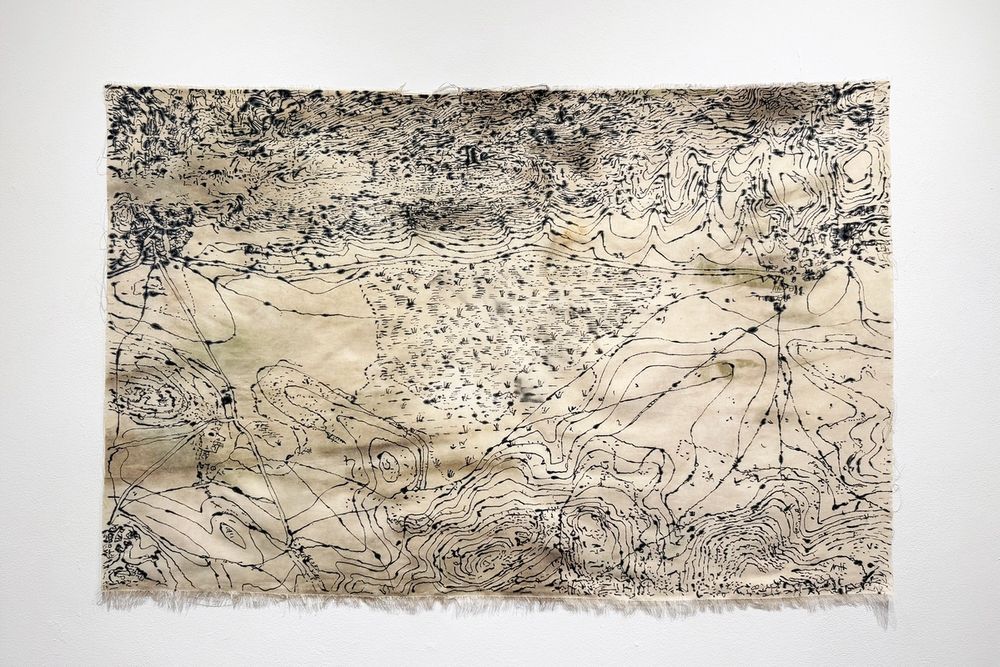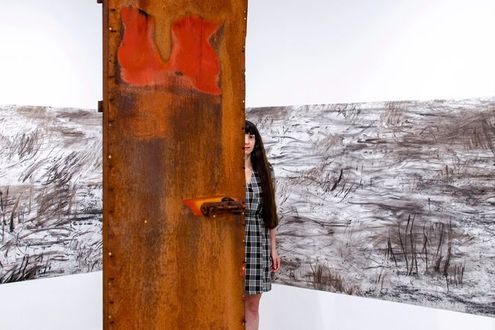Maria Nalbantova, Artist-in-Residence at the Dragoman Marsh Action Site as part of the WaterLANDS project, presented her new solo exhibition “SWAMPING” – a profound continuation of her inquiry into wetland restoration, ecology and transformation. The exhibition was on display from September 25th until October 11th, 2025 in Little Bird Place gallery in Sofia.
Curator’s note
A marsh is a specific kind of territory—the meeting of water and land. In common imagination it is an inhospitable place, a realm of silt and mud where strange creatures lurk at the boundary between the real and the invented. Seen through the biologist’s eyes, however, marshes are intensely vital territories—key ecosystems in which life manifests and thrives in a multitude of diverse forms.
Maria Nalbantova offers yet another perspective: the marsh can also be perceived as a metaphor for the human subconscious, a place where egrets and cranes fly overhead, but where wastewater may just as well flow in. Until not long ago, it was common practice to drain marshlands, as they were regarded as valuable plots of land on which, instead of useless silt and bulrush, one could have a cereal monoculture. In this way unique ecosystems vanished forever from the face of the earth; species and processes disappeared.

The Dragoman Marsh, located not far from Sofia, is one of the special marshes in Bulgaria—special perhaps above all because, despite drainage activities that left it dry for a long period, it exists today, having preserved its powers of renewal and its biological diversity.
Over the last three years, as part of a WaterLANDS Artistic Engagement Residency at the Dragoman Marsh, visual artist Maria Nalbantova has focused her attention on this ecosystem—on its history, its biodiversity, and its current state. In her practice, ecology and art interweave, opening many interesting and important avenues for reflection. Thus Maria became an artist of the marsh; interpreting various ecological themes and concerns through her gaze and artistic position, she realized a series of compelling projects—“Paradise Marsh” and “Shameless Ashes.”
The present exhibition continues her work as an artist researching and interpreting the issues, condition, and the theme of the restoration of the Dragoman Marsh, and it bears the title SWAMPING.

The artist turns her attention to the processes of sinking and surfacing—both as real phenomena in nature and as a metaphor for the human subconscious. In this project Maria presents her newest works, connected to her interest in ceramics. The material carries its own semantics and conjures an image of mud, as if scooped from the bottom of the Dragoman Marsh. The irregular rounded forms of these ceramic pieces, their textures and apertures, summon associations with water, earth, and living organisms—all those microscopic creatures that our eyes cannot catch but without which life would not flourish within this particular ecosystem. Marshes are alive and unpredictable; in them nature pulses by invisible laws, and Maria’s works impress this upon us through the harmony of their “naturalness.” Into the openings of the ceramic forms the artist weaves fragments of canvas that was deliberately “swamped” (here the term is used by analogy with “buried”) at the bottom of the Dragoman Marsh and left there for six months.

The theme of submergence and of the transformations that occur as a result of it occupies a central place in this project. Maria almost ritually buries two canvases in the marsh, but later finds only one of them; the other has been carried away by natural processes in an unknown direction. The symbolic gesture of immersion opens many lines of reflection. There is something deeply metaphorical in the idea of the marsh’s memory—it recalls human memory, in which certain things sink but do not disappear; one leaves them in one place only to fail to find them there, because invisible forces have silted them over. Yet nothing is lost. Even now, somewhere at the bottom of the Dragoman Marsh, beneath layers of silt, lies the canvas Maria left with the desire to capture the elusive memory of this place. In this way her ceramics are connected to processes in nature, but they also prompt us to think about the nature of the human subconscious. It is a semantically laden, invisible matter that resembles transparent silt; it draws things into itself, and the processes of sinking and surfacing are not always within our control.
A special place in the exhibition is given to a work based on an old topographic map from the early twentieth century that shows the marsh with its boundaries before it was drained. The artist’s interest is drawn to a remarkable plant species inhabiting the marsh—the waterwheel plant Aldrovanda, which is also present visually in the exhibition. The story of this plant’s discovery in Bulgaria’s flora is engagingly told by Stefan Stanev in the book Stars Fade in the Mountains. Maria begins her study of Aldrovanda from this account. It is a carnivorous plant that has no root and floats freely in the water. Today it is here; tomorrow it is gone. In the winter months it transforms into a more compact state and sinks to the bottom, where it remains until spring, when it resumes its floating form and rises to the water’s surface to continue its development. Aldrovanda is extremely vulnerable, and its only known habitat in Bulgaria at the time disappeared when the Dragoman Marsh was drained. In 2008, thanks to the efforts and research of experts from the Balkani Wildlife Society, the species was reintroduced to its original site. The artist finds this intriguing plant, but at her next search she cannot locate it—much like the canvas left on the bottom. In the image of Aldrovanda the metaphor of sinking is concentrated (into the marsh, into the past, into the present, into the subconscious). This aquatic plant, drifting through silty waters—infinitely fragile and vulnerable, yet having evolved remarkable mechanisms for survival—becomes a kind of symbol of disappearance, return, and rediscovery.
— Written by Lyuben Domozetski


